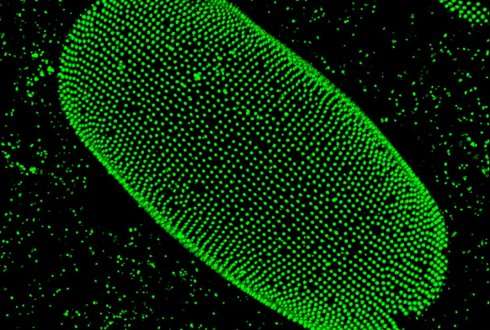Spheres can form squares

Everybody who has tried to stack oranges in a box knows that a regular packing of spheres in a flat layer naturally leads to a hexagonal pattern, where each sphere is surrounded by six neighbours in a honeycomb-like fashion. In an article just published on-line in PNAS, researchers from Wageningen University report an exception to this rule: when small, micrometer-sized particles are placed on a curved oil-water surface, they arrange in a square pattern, as on a chessboard.
Crystal structures
Since a number of decades, scientists are looking for strategies to create ordered crystal structures of regularly arranged small particles. Such crystals are interesting, because they can be used to control, modulate, or steer visible light in applications like lasers or other optical devices. While creating hexagonal patterns is relatively easy – this is the natural way in which the particles tend to order – anything different from that is much more difficult.
Surface tension
The team from the Laboratory of Physical Chemistry and Colloid Science at Wageningen University, part of Wageningen UR, has now found a way to create square particle arrays. To do this, they make use of the surface tension of the underlying oil-water surface, that is the tendency of the surface to minimize its area. When a particle sticks to the liquid surface it deforms the surface somewhat, and thereby increases the total area. The surface tension acts to minimize these deformations, by clustering all the particles together. This effect is also responsible for the clumping of breakfast cereals in a bowl of milk or of bubbles at the surface of a soft drink.
Attraction and repulsion
The researchers have found that this effective attraction between particles resulting from the surface tension depends on how the liquid surface is curved. A slight curving of the surface already makes the interaction between particles highly dependent on their relative orientation, with attraction in two perpendicular directions and repulsion in the other directions. This is what causes the particles to arrange spontaneously in square patterns.
High-tech optical applications
The researchers believe that their findings will lead to new bottom-up strategies for the design of structured materials, to be used in high-tech optical applications.
More information: Ershov, D. et al. Capillarity-induced ordering of spherical colloids on an interface with anisotropic curvature, PNAS (early edition, May 2013).
Journal information: Proceedings of the National Academy of Sciences
Provided by Wageningen University


















